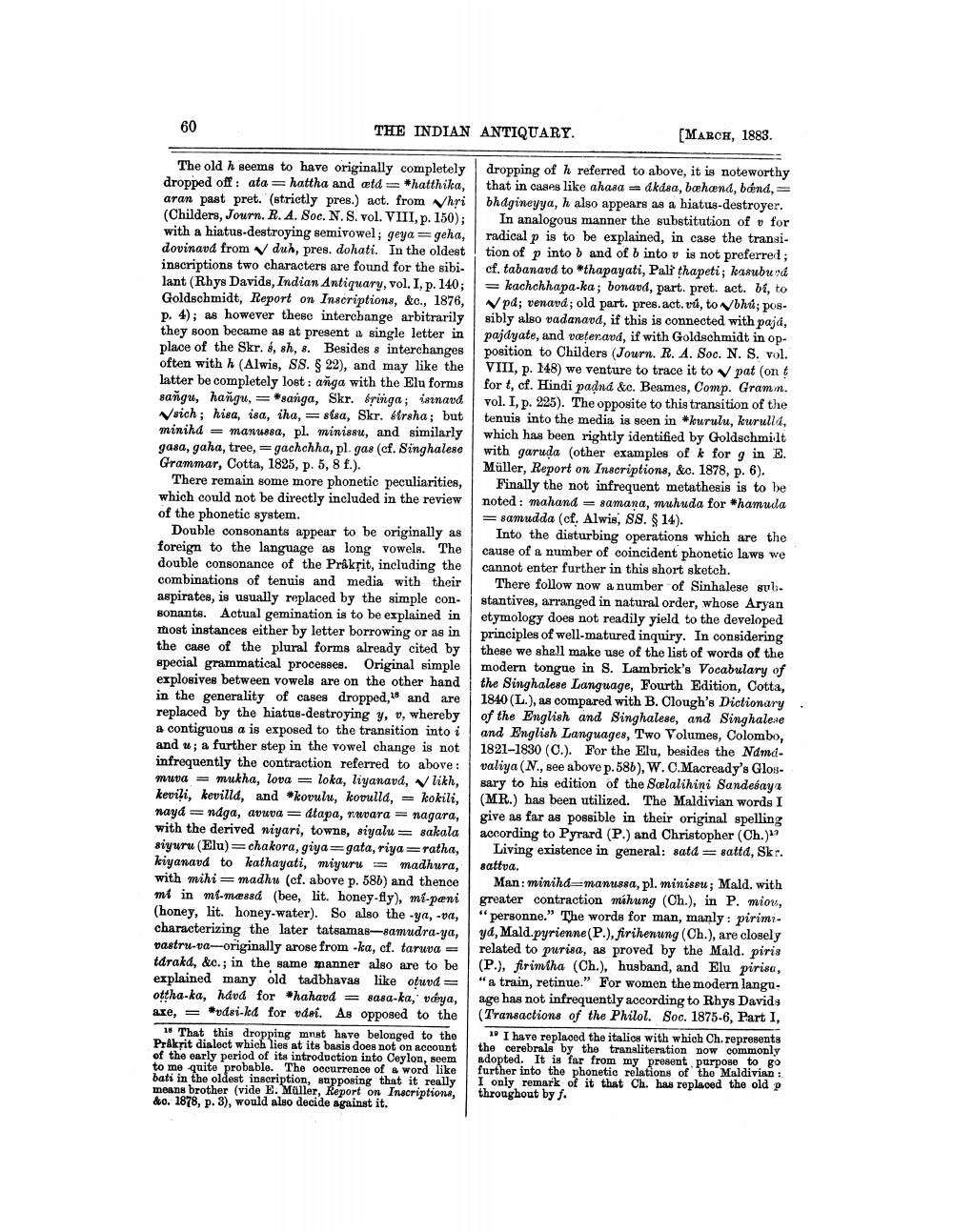________________
60
THE INDIAN ANTIQUARY.
[MARCH, 1883.
The old h seems to have originally completely dropping of h referred to above, it is noteworthy dropped off : ata=hattha and ætd = *hatthika, that in cases like ahasa = dkdea, bæhænd, boend, - aran past pret. (strictly pres.) act. from Vhri bhagineyya, h also appears as a hiatus-destroyer. (Childers, Journ. R. A. Soc. N. S. vol. VIII, p. 150); In analogous manner the substitution of for with a hiatus-destroying semivowel; geya=geha, radical p is to be explained, in case the transidovinavd from v duh, pres. dohati. In the oldest tion of p into b and of b into v is not preferred; inscriptions two characters are found for the sibi. cf. tabanard to *thapayati, Pali thapeti; kasubund lant (Rhys Davids, Indian Antiquary, vol. I, p. 140; = kachchhapa-ka; bonavd, part. pret. act. bi, to Goldschmidt, Report on Inscriptions, &c., 1876, ✓pd; venavd; old part. pres. act.vú, to bhů; pos. P. 4); as however these interchange arbitrarily sibly also vadanavd, if this is connected with paja, they soon became as at present a single letter in pajdyate, and væteravá, if with Goldschmidt in opplace of the Skr. &, sh, 8. Besides 8 interchanges position to Childers (Journ. R. A. Soc. N. S. vol. often with h (Alwis, SS. $ 22), and may like the VIII, p. 148) we venture to trace it to pat (on latter be completely lost: anga with the Elu forms for t, cf. Hindi padná &c. Beames, Comp. Gramm. sangu, hañgu, = *sanga, Skr. bringa; isinavd. vol. I, p. 225). The opposite to this transition of the Vsich; hisa, isa, iha, = sisa, Skr. ffrsha; but tenuis into the media is seen in *kurulu, kurulld, miniha = manussa, pl. minissu, and similarly which has been rightly identified by Goldschmilt gasa, gaha, tree,=gachchha, pl. gas (cf. Singhalese with garuda (other examples of k for g in E. Grammar, Cotta, 1825, p. 5, 8 f.).
Müller, Report on Inscriptions, &c. 1878, p. 6). There remain some more phonetic peculiarities, Finally the not infrequent metathesis is to be which could not be directly included in the review noted: mahand = samana, muhuda for *hamuda of the phonetic system.
=samudda (cf. Alwis, ss. $ 14). Double consonants appear to be originally as Into the disturbing operations which are the foreign to the language as long vowels. The cause of a number of coincident phonetic laws we double consonance of the Praksit, including the cannot enter further in this short sketch. combinations of tenuis and media with their There follow now a number of Sinhalese sul. aspirates, is usually replaced by the simple con- stantives, arranged in natural order, whose Aryan Bonante. Actual gemination is to be explained in etymology does not readily yield to the developed most instances either by letter borrowing or as in principles of well-matured inquiry. In considering the case of the plural forms already cited by these we shall make use of the list of words of the special grammatical processes. Original simple modern tongue in S. Lambrick's Vocabulary of explosives between vowels are on the other hand the Singhalese Language, Fourth Edition, Cotta, in the generality of cases dropped, and are 1840 (L.), as compared with B. Clough's Dictionary replaced by the hiatus destroying y, v, whereby of the English and Singhalese, and Singhalexe a contiguous a is exposed to the transition into il and English Languages, Two Volumes, Colombo, and u; a further step in the vowel change is not 1821-1830 (0.). For the Elu, besides the Namd. infrequently the contraction referred to above: valiya(N., see above p. 586), W. C.Macready's Glosmuva = mukha, lova = loka, liyanavd, likh, sary to his edition of the Sælalihini Sandeśayı kevili, kevilld, and *kovulu, kovulla, = kokili, (MR.) has been utilized. The Maldivian words I naya = ndga, avuva=dtapa, nuvara = nagara, give as far as possible in their original spelling with the derived niyari, towns, siyalu = sakala according to Pyrard (P.) and Christopher (Ch.)? siyuru (Elu)=chakora, giya=gata, riya=ratha, Living existence in general: satd=satta, Skr. kiyanavd to kathayati, miyuru = madhura, sattva. with mihi=madhu (cf. above p. 586) and thence Man: miniha-manussa, pl. minissu; Mald. with mi in mi-mæssd (bee, lit. honey.fly), mi-peni greater contraction mihung (Ch.), in P. miou, (honey, lit. honey-water). So also the -ya, -va, "personne." The words for man, manly: pirimicharacterizing the later tatsamas-samudra-ya, yd, Mald.pyrienne (P.), firihenung (Ch.), are closely vastru-a-originally arose from -ka, cf. taruva = related to purisa, as proved by the Mald. piris tdraka, &c.; in the same manner also are to be (P.), firimiha (Ch.), husband, and Elu pirisa, explained many old tadbhavas like otuvd = "a train, retinue." For women the modern langu. ottha-ka, havd for *hahavd = sasa-ka, vdya, age has not infrequently according to Rhys Davids are, = *vdsi-kd for udel. As opposed to the (Transactions of the Philol. Soc. 1875-6, Part 1,
That this dropping must have belonged to the 10 I have replaced the italics with which Ch. represents Prakrit dialect which lies at its basis does not on account the cerebrals by the transliteration now commonly of the early period of ita introduction into Ceylon, seem adopted. It is far from my present purpose to go to me quito probable. The occurrence of word like further into the phonetic relations of the Maldivian : bati in the oldest inscription, supposing that it really I only remark of it that Ch. has replaced the old p means brother (vide E. Muller, Report on Inscriptions, throughout by f. &o. 1878, p. 3), would also decide against it.




